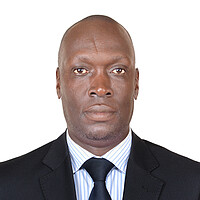A brighter future: Solar power charges rural education in Uganda
Loading...
| Bwengure, Uganda
When Charles Barigye first opened Trinity Senior Secondary School in the Uganda’s Bwengure village in 2015, there was no chance of connecting to the electrical grid. The school was six miles from the electrical wires connecting the town of Mbarara to Ibanda, the closest hook up.
So the school’s boarding students studied by the flicker of candle-light, until one burnt a girl’s mattress. The school tried kerosene lanterns. But these were dim, expensive, and produced a foul odor.
But everything changed when Mr. Barigye installed the school’s first solar panel. For 500,000 Uganda Shilling (about $130), he was able to install a 30-watt unit on the girls’ dormitory, providing the students with electric lighting for the first time.
Why We Wrote This
Globally, some 14 percent of people lack access to electricity. Electrifying entire nations can be difficult where infrastructure is lacking. In Uganda, rural residents are making their own light, thanks to solar power.
“The light is brighter, and the girls are safe as there are no longer dark spots,” says Barigye.
Since then, he has added panels piecemeal, 30 watts here, 50 watts there.
The difference has been felt throughout the school, as students, teachers, cooks, and parents all say they have seen a fundamental change since Barigye brought light.
Barigye says he has noticed particular improvement in his boarding students. And they are rapidly outpacing the commuter students who may not have access to any electricity at home.
“There is a sharp difference between the day scholars and boarders and this I attribute to attention,” he says. “There can’t be attention when there is no light.”
Empowering the disconnected
Uganda has one of the lowest electrification rates in Africa, with just 20 percent of residents connected to the grid.
Some households have off-grid connections, like Barigye’s school, but estimates suggest that three-quarters of Ugandans have no electricity access. In rural areas, like Bwengure, that figure is closer to 90 percent.
The most common source of lighting in rural communities is still a tadoba, a tin kerosene lamp made locally. These lamps put out little light and have been identified as a major source of indoor air pollution in rural homes.
But slowly, solar power is transforming rural communities here in Bwengure and the greater Mbarara District, as individual families have installed panels of their own. It has become more common to see refrigerators in small markets and electric lighting in schools, hostels, and hospitals.
“Solar energy has the highest energy potential in Uganda after hydro,” says Noah Asinge, the information and partnerships officer at Uganda National Renewable Energy and Energy Efficiency Alliance, a body that brings private renewable dealers together.
Located on the equator, Uganda is in a prime location to harness solar energy. Hydroelectric power remains the major supplier to the national electrical grid, but in recent years, two 10-megawatt solar farms have come online as well.
In recent years, Mr. Asinge says, the government and a host of nongovernmental organizations have launched programs to help bring solar power to Uganda’s rural communities.
Asinge says alliance members are working with the World Bank, the Rural Electrification Agency, and Power Africa Uganda Electricity Supply Accelerator to increase solar access.
Patrick Muinda, a spokesperson for the Ministry of Education and Sports, says they have been able to install solar systems in 560 secondary schools and technical institutes with support from the World Bank.
The Energy for Rural Transformation Project has been running since 2010. Mr. Muinda says the systems provide lighting in classrooms, dormitories, and labs. A new phase is planned to add enough battery storage capacity to run computer labs.
The addition of electric light alone, however, can make a huge difference for students.
The power of light
Edmond Nuwahereza a student at Saint Andrew Senior Secondary School Rubindi in Mbarara District, says access to lighting added hours to his day, enabling him read in the morning and evening.
A solar installation at home has paid off big, according to Shibaton Karungi, a student at Trinity Senior Secondary School. She was always a decent student, ranking 36th out of 90 students, even when she had to squint by lantern light. Since transitioning from tadoba to electric light, however, she is now 12th in her class.
“It is bright,” she says, smiling she recalls the dim light of the tadoba.
For her father, the investment in solar panels was a step toward living a modern life.
“I wanted to have modern lighting in my house,” he said. “The light is enough.”
Dorcus Nisiima of St. Benedict Secondary School in Kagongi, Mbarara District, also attributes improvements she has seen in her schoolwork to the addition of solar power at home. Her father, who runs a local hangout at his home, had installed solar to power a sound system and to light the kitchen where he prepares pork for the revelers.
Dorcus says the lights have enabled her to study in the dead of night after everyone else has gone to sleep.
Back in Bwengure, Barigye says solar is not only helping his students study. Now students can gather around a television to watch the evening news and enjoy movies on the weekends. It has offered them a connection to the broader world.






